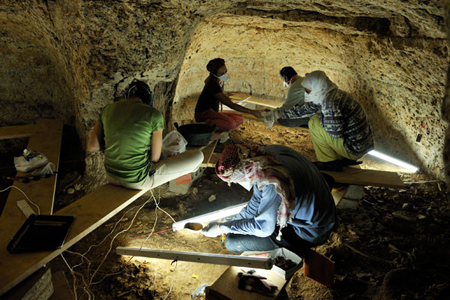 The ongoing dig at the ancient royal town of Qatna, Syria, has brought some exciting new discoveries to light.
The ongoing dig at the ancient royal town of Qatna, Syria, has brought some exciting new discoveries to light.
Among the skeletal remains, archaeologists have found precious gold jewellery, gemstones, alabaster vases, detailed ivory artefacts, tiny figurines.
Since the start of this year’s excavation mid-July, a total of 379 artefacts were recorded in the tomb.
The archaeological mission a Syrian-German cooperation between the University of Tubingen and the Syrian governement is further excavating the royal sepulchre that was discovered last year under the northwest wing of Qatna’s royal palace.
Among the burial gifts, a number of Egyptian object are of particular interest.

The finds reveal that was contact and trade between between the Syrian kingdom of Qatna and the kingdom of the Pharaohs.
They include a hippopotamus of glazed stone with a marshy landscape painted on his body and a tiny orange-red carnelian sphinx.
The archaeologists found many Egyptian alabaster perfume containers, as well as two small, finely crafted, almost transparent vessels made from rock crystal. (Yet, the monkey make-up container remains my favourite.)
Most stunning amongst the jewellery is a golden bangle, decorated with a lapis lazuli seal, and a gold plaque engraved with the ‘three of life’.
These burials are dated to between 1650 and 1550 BC, which is confirmed by the earlier discovery of a seal belonging to an Egyptian Princess.
Besides the burial gifts, the team also found more skeletal remains in the two burial chambers.
The bones were originally stowed together in boxes, which is clear from the traces of decomposed wood found.
Exactly how many persons were buried in the two rooms isn’t known yet, but more than 30 skulls have been discovered so far.


Bones from multiple skeletons and the remains of a wooden coffin (above) and pottery (below). Both photographed by Marc Steinmetz during the Juli-August 2010 excavations in the southern room.
It is likely the remains belong to persons from Qatna’s royal family or household.
Possibly, they were originally entombed in the Palace’s royal crypt (discovered in 2002) and only later reburied in the newly found tomb.
Previous finds from the remains of the royal palace include intact burial chambers and 73 tablets inscribed in a hybrid of Akkadian and Hurrian, likely the original language of what is today Turkey and the Caucasus.
The royal correspondence includes a 3,000-year-old warning from Hittite general Hanutti to the king of Qatna Idanda, telling him to prepare for war.
Qatna is located at the edge of the Syrian desert, towards the fertile Homs-Bassin and the archaeological area is about 1 square kilometre.
The earliest finds at the site date to the mid or late 3rd millennium BC.
During the Middle and Late Bronze Age, Qatna was one of the major kingdoms in Syria and in its heyday, from 1800 to 1600 BC, it was one of the most powerful nations in the East.
The city-state existed continiously from about 2000BC to 1340BC, it was sacked and burned to the ground by the Hittites.
Today still, part of its city walls – which enclosed a square area, unusual for a Bronze Age town – stand and impressive 20 metres high.